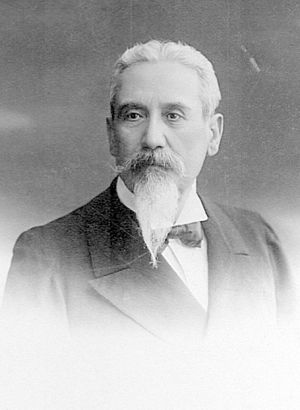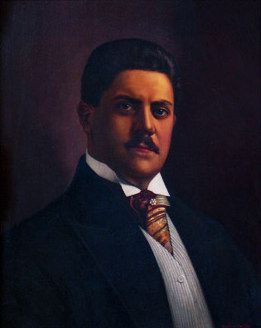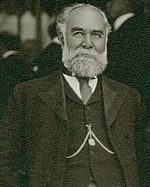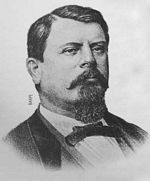Signatories of the Banco de Nuevo León
Interventor
|
Benigno Guerrero was born about 1839, the son of José Maria Guerrero and Maria Monica Animendi. He was Jefe de HaciendaCEHM, Fondo DLI-1 Copiadores del General Bernardo Reyes (1889-1911), 8.5069 when he was appointed Interventor on 18 August 1892. He died in June 1896, while still Jefe de HaciendaCEHM, Fondo DLI-1 Copiadores del General Bernardo Reyes (1889-1911), 19.12243 letter Bernardo Reyes to Francisco M. Coghlan, 14 June 1896. Guerrero signed notes dated from 1892 to 1897. |
 |
|
Mariano Otero y Arce was the Jefe de Hacienda for Nuevo León. He took over as Interventor in December 1897, though he did not make his formal acceptance until 14 January 1898CEHM, Fondo CDLIV, Colección José Y. Limantour, 1a.1883, carpeta 39, legajo 10288. He only lasted a few months. |
 |
|
Luis G. Camacho was appointed interventor on 28 August 1898CEHM, Fondo CDLIV Colección José Y. Limantour, 1a. 1883, carpeta 9, legajo 2359. Camacho signed notes dated 1900 to 1904. |
 |
|
Juan J. Farías’s parents owned the Hacienda de Bocas, situated 40 kilometres north of San Luis Potosí, and in his youth he managed the hacienda on their behalf. However, the hacienda passed into the hands of Jesús García in 1900. Perhaps in anticipation in August 1897 Farías had the governor of San Luis Potosí, Carlos Díez Gutiérrez, ask Limantour to appoint him Interventor of the proposed Banco de San Luis PotosíCEHM, Fondo CDLIV Colección José Y. Limantour, 1a. 1883, carpeta 20, legajo 5222 and in September Farías had his parents’ friend, General Bernardo Reyes, governor of Nuevo León, write to Limantour with the same requestCEHM, Fondo CDLIV Colección José Y. Limantour, 1a. 1883, carpeta 43, legajo 11318. Farías was unsuccessful but was appointed Interventor of the Banco de Guanajuato in August 1900. Farías signed some notes for the Banco de San Luis Potosí in 1903 and then signed notes for this bank dated from 15 September 1904 to 1 January 1910 |
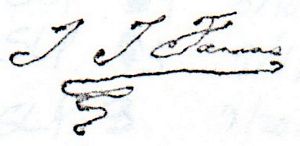 |
|
Jeronimo Treviño Galindo Trevio signed some $20 notes dated 1 January 1910 and then notes dated fromñ 5 May 1910 to 1914. |
 |
|
Javier Larrea was a Inspector visitador for the postal service by 1903, discovering frauds in various officesEl Imparcial, 17 June 1903, El Imparcial, 4 August 1903; El Contemporaneo, 29 August 1903. For example, he uncovered fraud in Tierra Blanca. Veracruz in 1907El Tiempo, 25 October 1907 and in Campeche in 1908La Voz de México, 26 May 1908. He was still in this post in November 1910El Heraldo Mexicano, 21 November 1910 and as such told the local post offices not to accept the notes of the Banco de Nuevo León. He signed the balance sheet for the Banco Mercantil de Monterrey 31 December 1910Diario Oficial, 18 January 1911. He took over as manager of the Banco de Nuevo León on 18 January 1911, to replace SobralEl Imparcial, 20 January 1911, in an attempt to restore the bank's reputation, but resigned on 20 May. For some reason, the night before a group of youths from the best of society, out on a serenade and somewhat drunk, gathered at his house, threw stones and broke the windowsEl Imparcial, 22 May 1911; Gaceta de Guadalajara, 28 May 1911. Larrea went back to being an inspector of post offices, and of custom housesEl Correo Español, 26 February 1913. In February 1913 under the new government Larrea was appointed interim Postmaster General (Director General de Correos)The Mexican Herald, 24 February 1913; El Imparcial, 26 February 1913 but was asked to resign five months laterEl Imparcial, Tomo XXXV, Núm. 7028, 4 July 1913. Later he was reported to be a Felicista agent. Larrea signed most of the notes dated 1 January 1911 (as interim?) but Treviño signed the $20 notes of that date. |
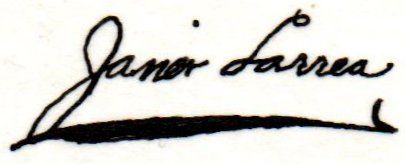 |
Presidente
|
Francisco Armendáriz y Arsuaga was born in Arcentales in the Basque region, Spain, on 15 October 1833, the son of Miguel Armendáiz (or Armendáriz) Máiz and Florentina Arsuaga. He became a successful entrepreneur who made a fortune in industry and agriculture. His interests included the Compañía Azucarera Mexicana in Linares, 130 kilometres southeast of Monterrey, which employed 70 workers to produce 200,000 to 250,000 kilogrammes of sugar and 30,000 litres of alcohol, and the famous store "El Palacio de Cristal" in Monterrey. When the Compañía Minera Fundidora y Afinadora de Monterrey (Fundición No. 2) was established on 21 July 1890 by Vicente Ferrara and the entrepreneurial elite of Monterrey, Francisco Armendariz invested $30,000 of the $600,000 share capitalANL, Fondos Notarios, Protocolo de Tómas Pacheco, f. 166-168, 21 June 1890 Acta constitutiva de la Compañía Minera Fundidora y Afinadora de Monterrey. Patricio Milmo and Santiago Belden both invested $9,000. He died while staying in room 101 of the Hotel Iturbide, in Mexico City, on 12 December 1900. The newspapers calculated his wealth at six million pesosEl Tiempo, Año XVIII, Núm. 5.165, 14 December 1900: La Gaceta Comercial, Año II, Núm. 62, 19 December 1900 . Armendariz signed notes dated 1892. |
 |
|
He was born in San Nicolás Hidalgo, Nuevo León on 2 December 1838, the son of a powerful landowner. After studying law he served as a judge and a deputy in the local congress. He was then Secretario General during the governorship of Jerónimo Treviño and became governor himself on 4 October 1879, taking over from Genaro Garza García, and handing it over to Garza García on 4 October 1881. He finally retired from public affairs in 1885 to concentrate on his private business and to administer the Madero fortune. In 1892, at the founding of the Banco de Nuevo León, he was appointed president of the Board of Directors. He resigned from this position at the beginning of the Revolution to be a candidate for the governorship in 1911. As a supporter of Madero, he was chosen governor for 1911 to 1915 but resigned after Madero’s assassination. He died in Monterrey on 24 September 1938, at the age of 100. Villarreal married Carolina Madero Hernández, a daughter of Evaristo Madero. He was the brother of Felicitos Villarreal, secretary of the treasury under the Convention, in 1914-1915. Villarreal signed notes dated 29 December 1892(?) to 16 September 1911 ($5 and $10 values). |
 |
|
Marcelino Garza was a businessman from Saltillo who controlled the Compañía Industrial Saltillera, associated with Evaristo Madero’s Compañía Industrial de Parras in the Compañia Industrial del Norte, S. A. Garza also signed notes dated 16 September 1911 ($20, $50, $500) and then notes dated to 15 May 1912. |
 |
|
Constantino de Tárnava Llano was born in Monterrey on 1 August 1862. He signed notes dated from 5 February 1912 (thus having some crossover with Garza) to 1914 but his signatures is also on notes with earlier dates thus: 15 February 1904 ($100), 15 September 1904 ($20), 27 November 1906 ($20, $50), 21 November 1908 ($20, $50), 5 May 1910 ($20, $50, $100) and 16 September 1910 ($20). He died in Monterrey on 7 January 1930. |
 |
Cajero
|
Andres Martínez Cárdenas Martínez Cárdenas signed notes dated from 1892 to 1895. |
 |
|
Amador Paz took over from Pedro Olvera at the beginning of August 1896The Two Republics, 8 August 1896: Semana Mercantil, 10 August 1896: Diario del Hogar, 11 August 1896. He signed notes dated 4 July 1897 and 18 October 1897. He was again interim cajero in 1916. |
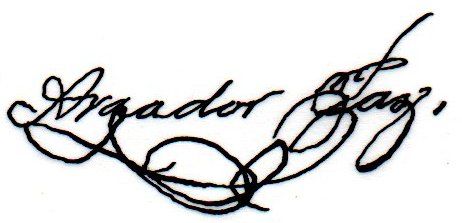 |
|
He signed $10 notes dated April 1896. |
 |
Gerente
|
Madero was from the powerful, regional Madero family He was born in Parras, Coahuila on 12 October 1872, the son of Evaristo Madero and uncle of the future president, Franciso I. Madero. He studied finance and mining at John Hopkins University, USA, and in France. In Coahuila he was a businessman and large landowner who administered the family's businessesBetween 1895 and 1912 Ernesto Madero was involved, as an oficial or shareholder, in the following companies: Ernesto Madero y Hnos, Salvador Madero y Cía, Compañía Explotadora Coahuilense, Compañía Industrial de Parras S. A., The Mexican Mining and Industrial Company, Compañía Minera, Fundidora y Afinadora Monterrey S. A., Negociación Minera Santa María de la Paz y Anexas, Compañía Minera Dolores de Guadalcazar S. A., Compañía Minera Restauradora de Guadalcázar S. A., Compañía Minera del Carmen S. A., Compañía Minera Carbonato S. A., Compañía Minera La Fraternal S. A., Compañía Minera Azteca S. A., Compañía Carbonífera de Nuevo León y Coahuila S. A., Compañía Metalúrgica de Torreón, Compañía Harinera de Chihuahua, Compañía Harinera del Golfo S. A., Jabonera de La Laguna S. A., Molinos de Cilindro de Monterrey, Fábrica de Vidrios y Cristales de Monterrey S. A., Compañía Fundidora de Fierro y Acero de Monterrey S. A. and Empresa Editorial de Monterrey. He sympathized with Joseph Ives Limantour and served as Secretario de Hacienda from 26 May 1911 until 18 February 1913. He and his brother Evaristo tried to negotiate with his nephew Francisco on the the cause of the Revolution but after the decena trágica he fled to Cuba and then the United States. He returned after the Revolution and died in Mexico City on 2 February 1958. Madero signed notes dated from 1900 to 1 February 1908. |
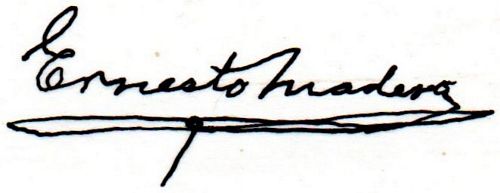 |
|
Rodolfo J. García was also a son-in-law of Evaristo Madero. He was appointed contador of the Banco Mercantil de Monterrey on 1 December 1899El Correo Español, 15 December 1899. He took over as managing director on 9 July 1908 but resigned in January 1911, supposedly for reasons of health. In fact he had learnt that Enrique Martínez Sobral, Jefe del Departamento de Crédito y Comercio of the local Secretaría de Hacienda, was going to take over the bank’s management, though on learning of the intrigue Sobral declined the invitation. However, Javier Larrea, the Interventor, then took over. Larrea was forced to resign as manager on 22 May 1911, following the fall of Porfirio Díaz, and Garza took over. Rodolfo J. Garza signed notes dated 21 November 1908 to 1 January 1911. |
 |
|
Rodolfo M. Garza took over as managing director from Javier Larrea in May 1911El Economista Mexicano, 30 September 1911. but resigned on 2 October 1911 when he was appointed Presidente Municipal. Rodolfo M. Garza signed some notes dated from 16 September 1910 ($20, $50 and $100) and then notes from 16 September 1911 to 1914. |
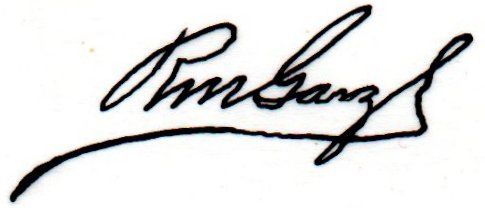 |
Other personages
|
José Antonio Víctor Hernández y Benavides was born on the hacienda of Guadalupe, San Juan Bautista del Río Grande, Coahuila, on 6 March 1845, the son of Captain Marcos Hernández Montalvo, jefe político of the Partido de Río Grande. In 1871 he married Ana María González Treviño, sister of Mercedes González Treviño (mother of Francisco I. Madero), with whom he had thirteen children. He was the brother-in-law of Evaristo Madero, who was married first to his half-sister, Rafaela Hernández Lombraña, and secondly to his first cousin, Manuela Farías Benavides (mother of Ernesto Madero Farías). His business activities concentrated on mining, agriculture and banking. In 1874 he founded the Minera San Pablo. In 1875 he joined, together with Francisco Madero Hernández, the company Madero y Cía (founded by Evaristo Madero and Lorenzo González Treviño in 1865). In 1887 he founded, together with Francisco Madero Hernández, the Madero y Hernández Sociedad Agrícola (dissolved in 1894), owner of six farms in La Laguna, one in Nuevo León, sixteen grazing sites in Coahuila, as well as other lands. In 1891 he founded the San Nicolás Mining Company on the San Nicolás Tolentino mines together with Manuel Romero Rubio, General Jerónimo Treviño, Viviano L. Villarreal, Andrés Farías Benavides, Evaristo Madero, among others. In 1894 he founded the Minera La Parreña. In 1897 he founded Minera Azteca S.A. and Minera Dolores S.A., as well as Compañía de Baños de Monterrey S.A. and the Las Mitras Brick Factory. In 1899 he appears as a shareholder of the Fábrica de Vidrios y Cristales de Monterrey S.A., both together with José A. Muguerza and Francisco G. Sada. In 1900 he founded the Minera del Norte and the Fábrica de Carton de Monterrey S.A. In 1902 he founded Minera Las Higueras S.A. and the Compañía de Aserrar Maderas de Caballeros S.A. In 1892 Hernández founded the Banco de Nuevo León, of which he was manager until 31 August 1899 when he left after certain disagreements and founded the Banco Mercantil de Monterrey, of which he was manager, shareholder and member of its board of directors. He was involved in the founding of the Banco Central Mexicano in 1899 and the Banco de Guanajuato in 1900. In 1904 he founded the Sociedad Cooperativa de Ahorros e Inversiones de Monterrey, with Andrés Farías Benavides, another brother-in-law of Evaristo Madero, as manager. From December 1882 to May 1883 Hernández served as governor of Coahuila, being preceded and succeeded by his brother-in-law Evaristo Madero. In 1901 he was appointed senator of the Federation, and held the presidency of the Senate in 1908. He died on 3 March 1926 at his home in Mexico City. |
|
|
Evaristo Madero subscribed $250,000 of the $600,000 initial share capital of the bank and was a member of the first board of directors. He died on 6 April 1911. |

